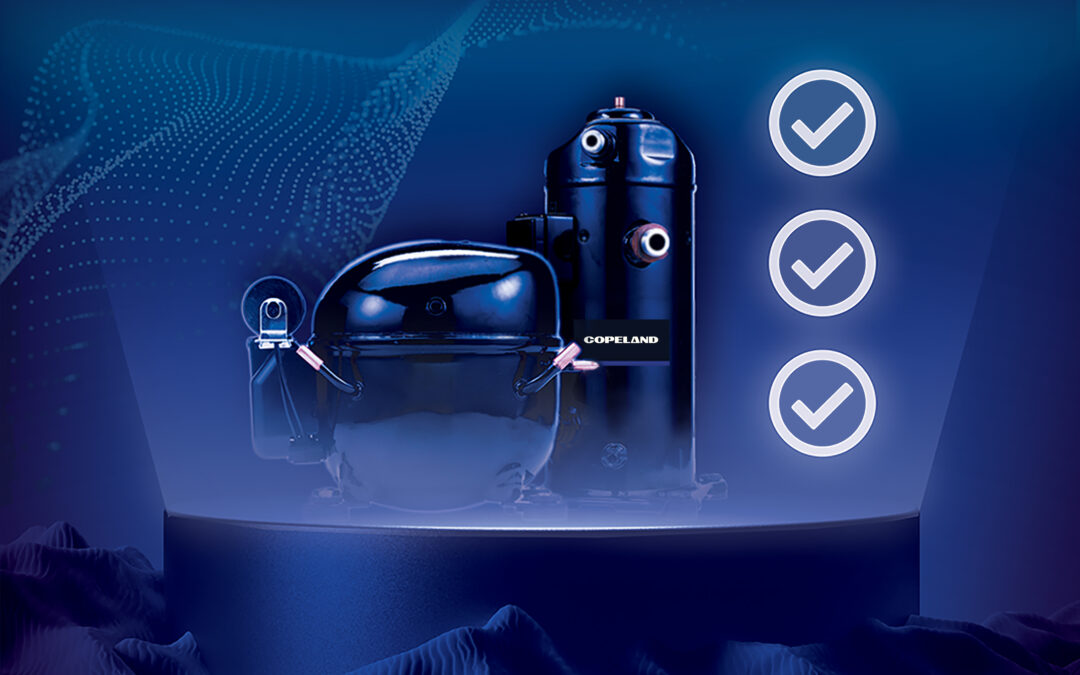*On June 1, 2023 Emerson’s Climate Technologies business became a new standalone company – Copeland. Though our name has changed, we are building on more than a century of HVACR innovation and industry leadership, and Copeland continues to offer the same products, industry stewardship, and learning opportunities you’ve grown to trust. Information found on this webpage posted before June 1, 2023 may contain our old name or branding, but you can be at ease knowing it was created with the knowledge and expertise of Copeland.
For several years, the regulatory landscape regarding the governance of refrigerants has been constantly shifting. Already in 2020, we’ve seen developments, both on the state and federal levels in the U.S., which will have significant impacts on the commercial refrigeration and air conditioning sectors for years to come. We recently published an E360 article that lays out these regulatory developments in detail; this blog is a condensed summary of its key points.

Global, national and state regulations have targeted the phase-down of hydrofluorocarbon (HFC) refrigerants with high global warming potential (GWP) and replacing them with lower-GWP options. But while emerging refrigerants — such as natural alternatives and new synthetic blends of HFCs and hydrofluoroolefins (HFOs) — offer environmental improvements, they are not without their operational caveats. Making the transition to these new alternatives will impact refrigeration architectures and raise concerns about performance and safety.
This dynamic combination of factors creates a complex regulatory mix that industry stakeholders have been actively working to resolve. To better understand the full context, we’ve summarized the major regulatory developments in the U.S. and abroad.
Update on EPA SNAP Rules 20 and 21
In 2017, the U.S. District Court of Appeals for the D.C. Circuit ruled to vacate the Environmental Protection Agency’s (EPA) Significant New Alternative Policy (SNAP) Rule 20 — ruling that the EPA did not have authority to require those who had already moved out of ozone depleting substances (ODS) to phase down to lower-GWP HFCs under its Clean Air Act (CAA). Subsequently, the EPA published a “Notification of Guidance,” stating that it would not enforce any of the HFC restrictions set forth in SNAP Rules 20 and 21 when drafting future regulations.
The Natural Resources Defense Council (NRDC) filed a lawsuit claiming that the 2018 Guidance was overly broad because it did not distinguish between ODS and HFC replacements, and that the EPA had not followed proper public notice-and-comment procedures to seek stakeholder input.
On April 7, 2020, the Court of Appeals granted the NRDC’s petition, stating that the EPA guidance was procedurally inappropriate. The court agreed that the initial 2017 decision required only a partial vacatur — not entirely eliminating the requirements SNAP Rules 20 and 21.
It’s important to remember that the industry had already made great strides toward meeting the mandates of SNAP Rule 20 after its passing in 2015, but these ongoing legal entanglements have left the U.S. without a clear path forward in terms of a unified refrigerant strategy. While the majority of the industry still supports the move toward a more sustainable and environmentally friendly future, court rulings around SNAP Rules 20 and 21 have created many questions about what the path forward will look like.
HFCs excluded from refrigerant management requirements
In response to the 2017 Court of Appeals ruling, the EPA also has rolled back other HFC-related regulations. Specifically, it excludes HFCs from the leak repair and maintenance requirements for stationary refrigeration equipment, otherwise known as Section 608 of the CAA. Other beneficial provisions of Section 608 — including the certified technician program and the refrigerant recovery and reclamation rules — are still in effect.
California continues to set the pace
The passing of California Senate Bill 1383 (the Super Pollutant Reduction Act) in 2016 called for Californians to reduce F-gas emissions (including HFCs) by 40 percent by 2030. Since then, the California Air Resources Board (CARB) had been using EPA SNAP Rules 20 and 21 as the bases of its HFC phase-down initiatives. The subsequent passing of California Senate Bill 1013 (the California Cooling Act) in 2018 mandated the full adoption of SNAP Rules 20 and 21 as they read on Jan. 3, 2017; the law is currently in effect.
To meet HFC reductions of 40 percent by 2030, CARB continues to hold public workshops and invited industry stakeholders to comment on the details of its second phase of proposed rulemaking, which currently states:
- Refrigerants with a GWP greater than or equal to 150 will not be allowed in new stationary refrigeration systems charged with more than 50 pounds, effective Jan. 1, 2022.
- Existing food retail facilities with refrigeration systems charged with more than 50 pounds must collectively meet a 1,400 GWP average or 55 percent greenhouse gas emission potential (GHGp) reduction over 2018 levels by 2030.
- Refrigerants with a GWP greater than or equal to 750 will not be allowed in new stationary air conditioning equipment, effective Jan. 1, 2023.
- Refrigerants with a GWP greater than or equal to 750 will not be allowed in chillers (including process chillers) greater than -15 °F and ice rinks, effective Jan. 1, 2024.
- Refrigerants with a GWP greater than or equal to 2,200 will not be allowed in new chillers ranging from -15 °F through -58 °F, effective Jan. 1, 2024.
CARB is planning to finalize these rulemaking proposals this summer and is still seeking industry input.
More states join U.S. Climate Alliance
In 2017, a coalition of 16 states and Puerto Rico emerged to form the U.S. Climate Alliance, with a shared commitment of reducing short-lived climate pollutants (SLCPs) and HFCs. Since then, the Alliance has grown to 25 members — comprising more than 55 percent of the U.S. population and an $11.7 trillion economy. Several states have announced plans to follow California’s lead on HFC phase-downs.
Refrigerant safety standards and codes under review
Meeting the targeted emissions reductions in California likely will require the use of low-GWP refrigerants. But many of these low-GWP, HFO refrigerants are classified as A2L, or mildly flammable. The natural A3 refrigerant R-290 (propane) also is becoming more widely used in low-charge, self-contained commercial refrigeration applications. Currently, national and global governing agencies are evaluating the standards that establish allowable charge limits and the safe use of these A2L and A3 refrigerants.
Per a 2019 update from the International Electrotechnical Commission (IEC) to IEC60335-2-89, A2L and A3 charge limits have been increased for commercial refrigeration systems:
-
- A2Ls — from 150g to 1.2kg
- A3s — 500g for factory-sealed systems, and will remain at 150g for split systems
Similar efforts to raise A2L and A3 charge limits also are taking place in the U.S. The American Society of Heating, Refrigerating and Air-Conditioning Engineers (ASHRAE) and Underwriters Laboratory (UL) are working to establish new charge limits and mitigations for the use of A2L and A3 refrigerants with support from industry and various stakeholders.
Once adopted, these standards will serve as the bases for codes that govern building, fire and other local authorities having jurisdiction (AHJ). It’s important to remember that building codes vary from state to state; thus, the adoption of flammable refrigerants ultimately may take place on local levels and may take years to accomplish.
Kigali Amendment not ratified in U.S.
In 2016, 197 member countries of the Montreal Protocol met in Kigali, Rwanda, and agreed on a global HFC phase-down proposal. The Kigali Amendment required ratification from at least 20 countries to take effect. To date, 92 countries (including many countries in the E.U., but not including the U.S.) have ratified it; it has been in effect for participating countries since Jan. 1, 2019.
According to industry estimates, ratifying the Kigali Amendment could create up to 33,000 jobs in the manufacturing sector by 2027 and have a positive impact on the U.S. economy. For these reasons, industry advocates are in favor of ratification and have demonstrated this through letters of support to both the Senate and the White House.
New HFC bills introduced in the U.S.
The U.S. Senate and the House of Representatives have each penned new bills that would put the EPA in alignment with the Kigali Amendment and restore the EPA’s authority to phase down the production and consumption of HFCs over a 15-year period.
-
- Senate: American Innovation and Manufacturing Act of 2019 (S2754)
- House: American Innovation Leadership Act of 2020 (HR5544)
While the future and timing of these new bills are uncertain, they offer the potential to re-establish a federal standard for HFC management, including guidelines for servicing, recovery, recycling and reclamation.
Industry appeals for consistency
Industry advocates, including the Air-conditioning Heating and Refrigeration Institute (AHRI) and the NRDC, have appealed for states to be consistent in their approach to adopting CARB’s rules. Establishing a unified framework for future refrigerant regulations would provide the certainty needed to help the industry and regulatory bodies move forward with a consistent approach. At Emerson, we’re actively involved in helping the HVACR industry evaluate and steer these proposals — in industry committees, stakeholder meetings and public comments.

Electrical component considerations for A2L system safety
Electrical component considerations for A2L system safety As a new refrigerant category in the...

A2L refrigerant regulation updates: what you need to know today
Preparing for the approval and safe use of A2Ls in commercial refrigeration applications The move...

Address Efficiency Mandates with Compression Technologies
Strategies for complying with DOE and ENERGY STAR® in self-contained and remote condensing units...
